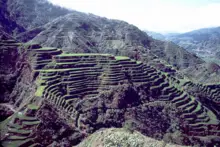Difference between revisions of "Banaue Rice Terraces" - New World Encyclopedia
Dan Davies (talk | contribs) (imported, credited) |
Dan Davies (talk | contribs) (article organized) |
||
| Line 13: | Line 13: | ||
}} | }} | ||
| − | Te '''[[Banaue]] Rice Terraces''' ({{lang-tl|Hagdan-hagdang Palayan ng Banaue}}) are 2000-year old [[Terrace (agriculture)|terrace]]s that were carved into the mountains of [[Ifugao]] in the [[Philippines]] by ancestors of the [[Batad]] indigenous people. The Rice Terraces are | + | Te '''[[Banaue]] Rice Terraces''' ({{lang-tl|Hagdan-hagdang Palayan ng Banaue}}) are 2000-year old [[Terrace (agriculture)|terrace]]s that were carved into the mountains of [[Ifugao]] in the [[Philippines]] by ancestors of the [[Batad]] indigenous people. The Banaue terraces are part of the '''Rice Terraces of the Philippine Cordilleras''', ancient sprawling man-made structures from 2,000 to 6,000 years old. They are found in the provinces of [[Apayao]], [[Benguet]], [[Mountain Province]] and [[Ifugao]], and are a [[UNESCO World Heritage Site]]. |
| − | The | + | ==Description== |
| − | + | The Rice Terraces are commonly referred to as the "[[Eighth Wonder of the World]]". It is commonly thought that the terraces were built with minimal equipment, largely by hand. The terraces are located approximately 1500 meters (5000 ft) above sea level and cover 10,360 square kilometers (about 4000 square miles) of mountainside. They are fed by an ancient [[irrigation]] system from the rainforests above the terraces. | |
| − | |||
| + | ==Local Peoples== | ||
| + | Locals to this day still tend to the rice and vegetables on the terraces, although more and more younger Ifugaos do not find farming appealing, often opting for the more lucrative hospitality industry generated by the Rice Terraces.<!--{{Fact|date=July 2007}}—> The result is the gradual erosion of the characteristic "steps", which need constant reconstruction and care. | ||
[[Image:Pana Banaue Rice Terraces.JPG|thumb|center|500px|Panoramic view of the Banaue Rice Terraces]] | [[Image:Pana Banaue Rice Terraces.JPG|thumb|center|500px|Panoramic view of the Banaue Rice Terraces]] | ||
| − | |||
| − | |||
| − | |||
==External links== | ==External links== | ||
{{Commons}} | {{Commons}} | ||
*[http://whc.unesco.org/en/list/722 UNESCO World Heritage Site Link] | *[http://whc.unesco.org/en/list/722 UNESCO World Heritage Site Link] | ||
| − | |||
{{World Heritage Sites in the Philippines}} | {{World Heritage Sites in the Philippines}} | ||
Revision as of 17:02, 27 June 2008
| Rice Terraces of the Philippine Cordilleras* | |
|---|---|
| UNESCO World Heritage Site | |
 Banaue Rice Terraces, Ifugao Province, Philippines. | |
| State Party | |
| Type | Cultural |
| Criteria | iii, iv, v |
| Reference | 722 |
| Region** | Asia-Pacific |
| Inscription history | |
| Inscription | 1995 (19th Session) |
| Endangered | 2001- |
| * Name as inscribed on World Heritage List. ** Region as classified by UNESCO. | |
Te Banaue Rice Terraces (Tagalog: Hagdan-hagdang Palayan ng Banaue) are 2000-year old terraces that were carved into the mountains of Ifugao in the Philippines by ancestors of the Batad indigenous people. The Banaue terraces are part of the Rice Terraces of the Philippine Cordilleras, ancient sprawling man-made structures from 2,000 to 6,000 years old. They are found in the provinces of Apayao, Benguet, Mountain Province and Ifugao, and are a UNESCO World Heritage Site.
Description
The Rice Terraces are commonly referred to as the "Eighth Wonder of the World". It is commonly thought that the terraces were built with minimal equipment, largely by hand. The terraces are located approximately 1500 meters (5000 ft) above sea level and cover 10,360 square kilometers (about 4000 square miles) of mountainside. They are fed by an ancient irrigation system from the rainforests above the terraces.
Local Peoples
Locals to this day still tend to the rice and vegetables on the terraces, although more and more younger Ifugaos do not find farming appealing, often opting for the more lucrative hospitality industry generated by the Rice Terraces. The result is the gradual erosion of the characteristic "steps", which need constant reconstruction and care.
External links
| |||||||
[[Category:]]
Credits
New World Encyclopedia writers and editors rewrote and completed the Wikipedia article in accordance with New World Encyclopedia standards. This article abides by terms of the Creative Commons CC-by-sa 3.0 License (CC-by-sa), which may be used and disseminated with proper attribution. Credit is due under the terms of this license that can reference both the New World Encyclopedia contributors and the selfless volunteer contributors of the Wikimedia Foundation. To cite this article click here for a list of acceptable citing formats.The history of earlier contributions by wikipedians is accessible to researchers here:
The history of this article since it was imported to New World Encyclopedia:
Note: Some restrictions may apply to use of individual images which are separately licensed.

